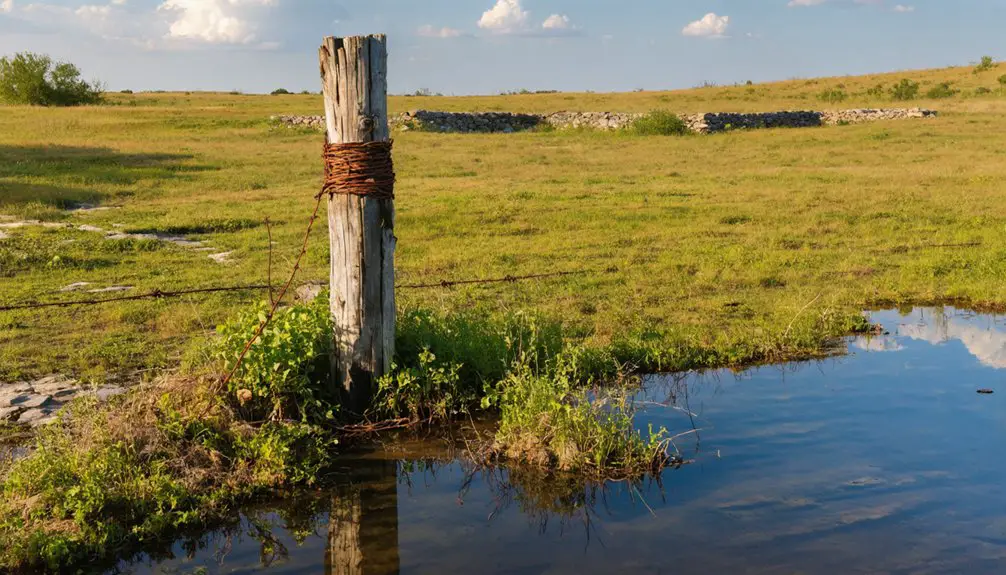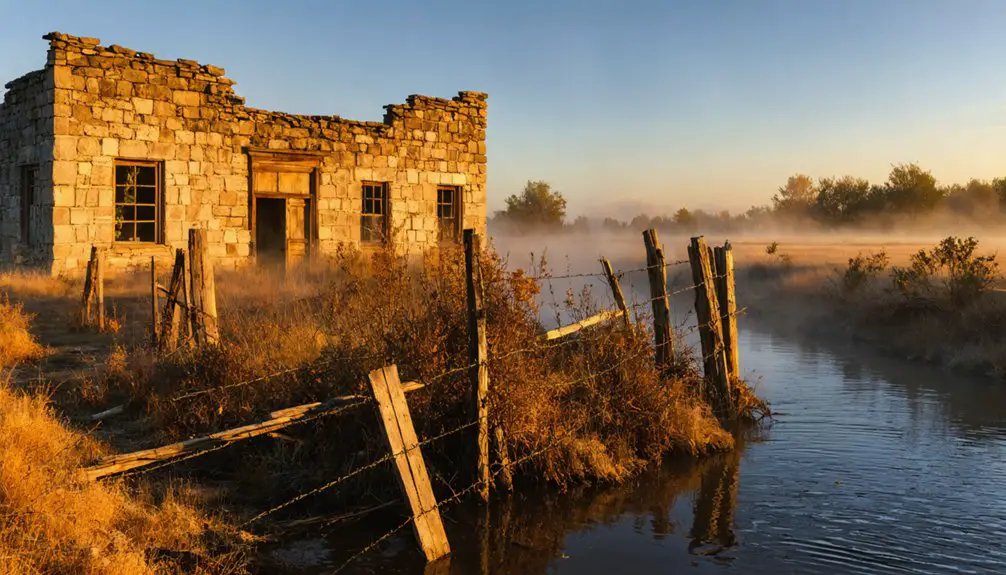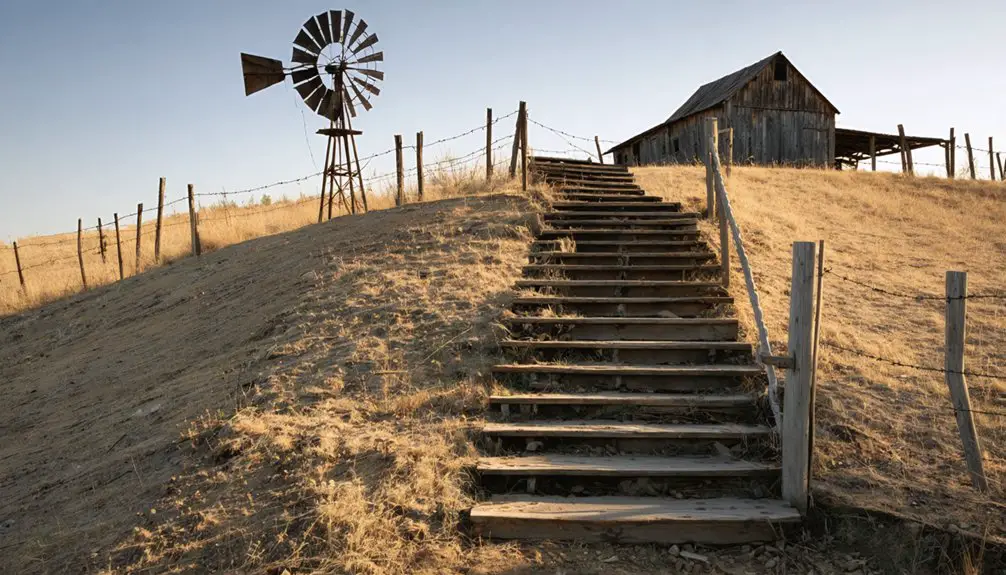You’ll find Chisholm Spring two miles east of Asher, Oklahoma, where Jesse Chisholm established an essential trading post in 1847. This bustling frontier hub featured the town’s only store and blacksmith shop, serving as an important meeting point for Plains Indians, settlers, and cowboys driving cattle along the famous Chisholm Trail. While the settlement’s physical structures have faded into Oklahoma’s landscape, the stories of multicultural exchange and economic prosperity still echo through time.
Key Takeaways
- Chisholm Spring was established in 1847 near Asher, Oklahoma, featuring the area’s only store and blacksmith shop before becoming a ghost town.
- The settlement declined after 1862 when Jesse Chisholm relocated to Kansas, eventually joining Oklahoma’s nearly 2,000 documented ghost towns.
- The site was a crucial trading post along the Chisholm Trail, where millions of cattle passed during the great cattle drives.
- Archaeological remains include building foundations and artifacts that tell the story of frontier commerce and cultural exchange.
- Local preservation efforts work to document and protect the ghost town’s historical significance through exhibits and historical records.
A Trading Post on the Frontier
In the fertile lands along the Canadian River, Jesse Chisholm established his trading post in 1847, about two miles east of what you’ll now find as Asher, Oklahoma.
The post quickly became a crucial hub in the frontier economy, featuring the town’s only store, a blacksmith shop, and a warehouse cabin for storing furs. The trading post was one of three Canadian River posts established by Col. Auguste Pierre Chouteau. A crude log structure near the spring served as Jesse’s home and business.
You’d have witnessed a vibrant scene of cultural exchange as Plains Indians, settlers, and gold rushers converged at this strategic location.
The post served as more than just a supply point on the California Road – it became a sanctuary where “Prairie Jess” fostered peaceful relations between tribes and settlers.
Here, you could find essential provisions, trade your furs, or seek help in recovering lost children from Comanche captivity, making it an irreplaceable lifeline for the region’s diverse communities.
Jesse Chisholm’s Vision and Legacy
Jesse Chisholm’s trading empire stretched across what you’d recognize today as Oklahoma, with his posts serving as essential hubs of commerce and cultural exchange between Native American tribes and settlers.
You’ll find his lasting influence reflected in the way he built bridges between diverse communities through his mastery of multiple Native languages and his deep understanding of both Cherokee and European-American customs.
His vision of peaceful trade and cooperation lives on in the stories of Chisholm Spring, where merchants and travelers once gathered at his trading post to exchange goods and share news of the expanding frontier. Being born to a Cherokee and Scottish heritage, Chisholm embodied the cultural diversity that characterized the American frontier. His established trading route would later become the famous cattle-driving path that transported millions of longhorns north to Kansas.
Trading Empire Builder
While many frontier traders focused solely on immediate profits, Chisholm’s remarkable vision for a connected trading empire stemmed from his unique cultural heritage and diplomatic talents.
His trading strategies blended Cherokee wisdom with European business practices, creating an economic influence that would reshape the American frontier.
Consider these pillars of Chisholm’s trading empire:
- Strategic trading posts positioned across Indian Territory to serve multiple tribes
- Mastery of fourteen Native languages, enabling direct negotiations without intermediaries
- Diplomatic relationships with both Native tribes and Euro-American merchants
- A network of safe, efficient trade routes that would later become legendary cattle trails
You can trace his legacy through the commercial corridors he established, which bridged cultural divides and created lasting economic partnerships between diverse communities across the frontier. The trail system he developed would later help solve the critical challenge of moving Texas longhorn cattle to market after the Civil War. In 1864, he established a crucial trading post at the Little Arkansas River that would serve as a vital hub for commerce in the territory.
Lasting Cultural Impact
Through his remarkable cultural bridging and diplomatic prowess, Chisholm’s influence on the American frontier extends far beyond the famous cattle trail that bears his name.
Born to a Cherokee mother Martha Rogers, his deep understanding of both Native American and European cultures shaped his role as a skilled mediator.
As a master of cultural exchange, his fluency in 14 Native American languages enabled him to foster peace and understanding between diverse tribes and settlers during a turbulent era of westward expansion.
His successful trading post operations near Wichita helped establish vital commerce networks between Plains tribes and settlers.
You’ll find Chisholm’s historical significance preserved at his burial site near Left Hand Spring, now listed on the National Register of Historic Places.
His vision of peaceful coexistence and economic cooperation lives on through the statue in Kingfisher, Oklahoma, and his 1974 induction into the Hall of Great Westerners.
Chisholm’s legacy as a frontier diplomat continues to remind us how one person’s commitment to cross-cultural understanding can shape the destiny of a region.
Daily Life at Chisholm Spring
You’d have found the trading post bustling with activity as Native Americans and travelers exchanged furs, supplies, and goods while the blacksmith’s hammer rang out across the settlement.
The post wasn’t just a place of commerce – it served as the heart of community life, where Plains Indians and settlers gathered to share news and foster relationships through Chisholm’s skilled interpreting.
In these daily exchanges at the stockaded post, Jesse Chisholm’s reputation as a peacemaker and friend to the tribes helped create an atmosphere of mutual respect and cultural understanding.
The Treaty of Medicine Lodge in 1867 brought significant changes to the trading patterns as it relocated the Cheyenne and Arapaho tribes to Oklahoma.
Cowboys would drive herds of up to 10,000 cattle past the trading post during their long journey northward.
Trade and Commerce Activities
At the heart of Chisholm Spring’s bustling frontier economy stood Jesse Chisholm’s Trading Post, established in 1847 as an important commercial hub connecting Plains Indians, settlers, and weary travelers.
The post thrived along important trade routes, including the California Road, where gold seekers stocked up on crucial supplies before their westward journey.
You’d find these daily commerce activities at the trading post:
- Fur trading with local tribes, with pelts stored in the attached warehouse
- Blacksmith services for tool repairs and horseshoeing
- Sale of important provisions to settlers and travelers
- Livestock trading as the region’s ranching economy grew
The post’s strategic location and diverse services created a significant economic bridge between cultures, supporting both local families and passing travelers while fostering peaceful commerce on the American frontier.
Social Gatherings and Interactions
While Jesse Chisholm’s trading post primarily served commercial needs, it quickly evolved into the settlement’s vibrant social hub where Plains Indians, settlers, and gold rush travelers forged lasting connections.
You’d find people gathering daily at the blacksmith shop, sharing stories while waiting for repairs or trading goods at the post. The Native American families who lived nearby maintained their traditional social customs, creating a rich multicultural atmosphere that defined life at the springs.
Community interactions flourished under Chisholm’s peaceful influence, as he worked to foster understanding between different groups.
Whether you were a local resident, a passing trader, or a California-bound traveler, you’d experience the unique blend of cultures that made this small but dynamic settlement a welcoming stop along the frontier.
The Rise and Fall of a Settlement
Founded in 1847 by the renowned frontier trader Jesse Chisholm, the settlement of Chisholm Spring emerged as an important commercial hub along the California Road in what would later become Oklahoma Territory.
The settlement dynamics reflected the spirit of the frontier, where traders and Native Americans freely conducted business at Chisholm’s well-equipped trading post.
- The settlement flourished initially, serving as a crucial supply point for California Gold Rush travelers in 1849.
- Economic fluctuations brought prosperity through fur trade, blacksmithing, and supply operations.
- The community thrived on diverse interactions between plains Indians and migrants.
- By 1862, the settlement’s decline began when Chisholm relocated to Kansas.
Without formal infrastructure and following Chisholm’s death in 1868, this once-bustling trading post gradually faded into the pages of Oklahoma’s frontier history.
Native American Relations and Trade

The heartbeat of Chisholm Spring’s frontier community centered on its remarkable Native American trade relations, carefully nurtured by Jesse Chisholm‘s unique diplomatic talents.
You’d find this Scotch-Cherokee trader speaking 14 Indian dialects, bridging cultural gaps between tribes and settlers through his trading post and blacksmith shop.
As you walked the grounds in those days, you’d witness economic exchanges between Plains Indians from vast territories, with wagon trains loaded with precious hides and manufactured goods.
Chisholm’s reputation for fairness made his post a trusted hub for intertribal diplomacy. Through his neutral stance during conflicts and his role in treaty negotiations, including the Medicine Lodge Treaty of 1867, he’d guarantee that Chisholm Spring remained an essential crossroads of commerce and cultural understanding.
The Trail That Changed Everything
Standing as one of America’s greatest cattle highways, the Chisholm Trail transformed Chisholm Spring from a modest trading post into a bustling frontier hub.
When you look back at this remarkable cattle migration, you’ll find it wasn’t just about moving herds – it sparked an economic transformation that changed the American West forever.
- You’d see trail bosses leading massive herds of 2,500 to 3,000 cattle, with some drives reaching an incredible 10,000 head.
- Your ancestors might’ve been among the skilled cowboys who moved these herds 10 miles daily.
- You can trace how the trail connected Texas ranchers to Kansas railheads, opening up eastern markets.
- You’re walking on ground that saw over five million cattle and one million wild mustangs pass through, making it America’s largest human-driven animal migration.
Preserving Oklahoma’s Hidden History

Scattered across Oklahoma’s rugged landscape lie nearly 2,000 ghost towns, each holding fragments of the state’s vibrant past.
From abandoned storefronts to crumbling foundations, Oklahoma’s ghost towns whisper tales of frontier dreams and faded glory.
You’ll find stories of resilience in these abandoned streets, where metal detectors uncover artifacts at sites like Cloud Chief, and local historians work tirelessly to document vanishing structures before they’re lost forever.
Ghost town preservation faces urgent challenges as buildings collapse and memories fade.
Yet dedicated communities are fighting to protect these historical treasures through interpretive exhibits at places like the Oklahoma Route 66 Museum.
They’re gathering oral histories, photographing remaining structures, and compiling detailed records from over 1,200 sources.
Whether it’s a mining town like Picher or a prohibition-era liquor town, each site’s historical significance tells a unique chapter in Oklahoma’s rich frontier heritage.
Frequently Asked Questions
Are There Any Visible Remains of the Original Trading Post Today?
You won’t find any visible remains of the historically significant trading post today, though its architectural footprint once featured a stockade, blacksmith shop, and fur warehouse that shaped frontier commerce.
What Specific Goods Were Most Commonly Traded at Chisholm Spring?
Like a frontier Walmart, the post traded essential trade goods: furs, blacksmith services, tools, provisions, and frontier supplies. You’d find everything from Native American pelts to gold rush travelers’ necessities.
How Many People Lived in Chisholm Spring During Its Peak?
You’d find that population growth never exceeded a few hundred people at its peak, with mostly traders and Plains Indians coming and going before the settlement’s decline in 1862.
Did Any Notable Outlaws or Lawmen Frequent Chisholm Spring?
While outlaw legends suggest Dalton and Doolin gangs might’ve visited your spring’s revitalizing waters, there’s no direct proof of specific lawman encounters at this freedom-loving frontier waypoint.
What Natural Water Sources Besides the Spring Supplied the Settlement?
You’d find the Canadian River served as your main water source, while natural reservoirs and smaller creeks provided backup supplies. Local water rights guaranteed your community’s access to these essential resources.
References
- https://en.wikipedia.org/wiki/Chisholm_Spring
- https://www.okhistory.org/publications/enc/entry?entry=CH045
- https://sites.rootsweb.com/~okpcgc/towns/chisholm_springs.html
- https://www.legendsofamerica.com/we-jessechisholm/
- https://www.wikiwand.com/en/articles/Chisholm_Spring
- https://www.frontiertimesmagazine.com/blog/in-land-chisholms-by-t-u-taylor-austin-texas
- http://blogoklahoma.us/place/473/blaine/jesse-chisholm
- https://unitedscotsok.com/blog/chisholm-trail-where-scottish-heritage-meets-the-american-west
- https://cowboyaccountant.com/2025/09/03/old-chisholm-trail-history/
- https://en.wikipedia.org/wiki/Jesse_Chisholm



